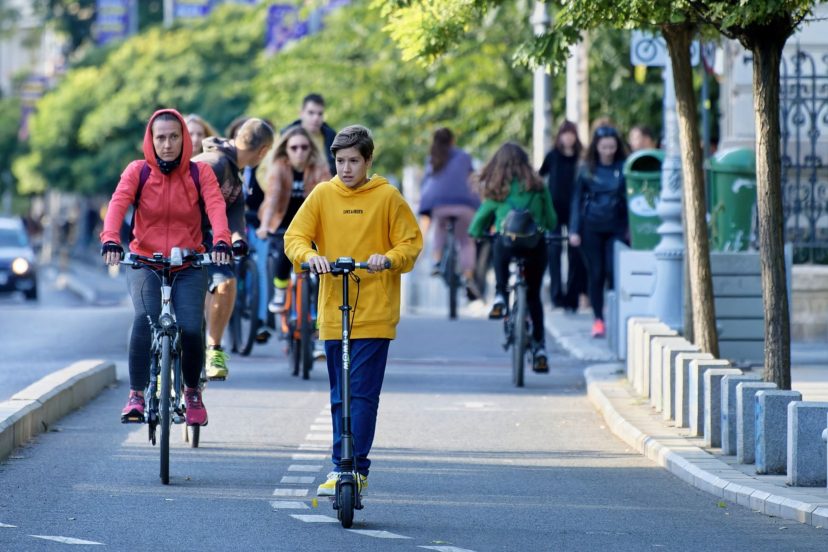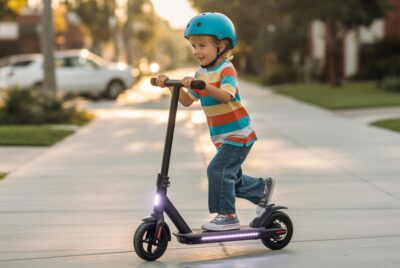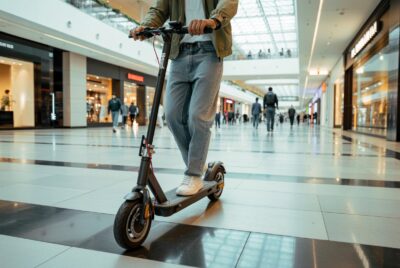Is Your Electric Scooter a Motor Vehicle? Key Insights Revealed
*We may earn a commission for purchases made using our links. Please see our disclosure to learn more.
Are you zipping through the streets on your electric scooter and wondering if it’s considered a motor vehicle? You’re not alone. Many riders are in a haze about where their speedy two-wheelers fit into the world of cars, bikes, and motorcycles.
Your e-scooter feels like just another way to get around town, but the law might see it differently.
Did you know that how an electric scooter is classified can vary wildly from one state to another? This could mean different rules for helmet use, road access, and even driver licenses.
In this blog post, we’ll dive into what makes an electric scooter tick, how they’re viewed in the eyes of the law, and why understanding this matters for your daily ride. Whether you’re a casual user or considering an e-scooter as your main transport mode, we’ve got insights ready for you.
Keep reading to discover what sets these nifty gadgets apart in the bustling world of urban transportation!
Defining Electric Scooters
Electric scooters, also known as e-scooters, are battery-powered devices that provide a mode of transportation for short distances. They are different from traditional scooters in that they do not require manual propulsion and are often used for shared mobility services.
There are various types of electric scooters available on the market, each designed for different purposes such as commuting or recreational use.
Differences from traditional scooters
Electric scooters pack a punch with their modern technology, standing out from traditional scooters in several ways. One of the biggest differences is speed control. Traditional kick scooters rely on physical effort to gain momentum, but electric variants zoom ahead with just a twist of the throttle, offering ease and quick acceleration without breaking a sweat.
They come equipped with rechargeable lithium-ion batteries that power an electric motor for consistent performance.
Traditional scooters often demand more from your muscles, especially when navigating uphill roads or long distances. On the other hand, e-scooters are built for comfort and efficiency during such rides.
Eco-friendliness also separates them from non-electric cousins; they emit no exhaust fumes and operate quietly, contributing positively to urban transportation trends by cutting down traffic congestion.
Moreover, innovation in safety features distinguishes electric scooters. Many models incorporate intelligent systems like those used by Bird scooters that gather data to enhance vehicle reliability over time automatically.
This stands in contrast to the straightforward mechanical design of old-school foot-propelled ones which lack electronic components entirely. As micromobility adoption grows and cities lean into scooter programs as part of their landscape, these advancements hint at how deeply integrated personal mobility devices might become in shaping future travel habits.
Types of electric scooters
Electric scooters come in various types, including stand-up electric scooters and seated electric scooters. These are further categorized into models designed for different age groups and purposes:
- Stand-up electric scooters are popular among teenagers and adults for short commutes and last-mile transportation.
- Seated electric scooters provide a more comfortable ride for longer distances and cater to a wider demographic, including older adults and individuals with mobility issues.
- Off – road electric scooters are designed with robust features to navigate rough terrains, making them suitable for adventurous outdoor activities.
- Folding electric scooters offer portability and convenience, allowing users to easily store or carry them when not in use.
- Electric kick scooters are compact and lightweight options ideal for urban travelers seeking agility amidst traffic.
Legal Classification of Electric Scooters
Electric scooters fall under the legal classification of motor vehicles in many states, but specific regulations may vary. Understanding these classifications and state-specific laws is essential for scooter riders and owners to ensure compliance with transportation laws.
Motor vehicle classification
Motor vehicle classification determines whether electric scooters are considered motor vehicles. State-specific laws play a significant role in this classification, with some states categorizing e-scooters as motor vehicles while others do not.
The speed at which an electric scooter travels is a determining factor; generally, they operate at lower speeds than traditional motor vehicles, potentially affecting their classification.
Additionally, the integration of electric scooter sharing programs into city transportation systems continues to impact how these devices are classified and regulated.
State-specific laws
In the United States, electric scooters are governed by a patchwork of state-specific laws that designate their legal classification. These regulations can significantly affect how and where e-scooters can be operated. Here’s an overview of state approaches to e-scooter laws in table format:
| State | Legal Classification | Max Speed | Helmet Requirement | Riding Location | Age Limit | Additional Notes |
|---|---|---|---|---|---|---|
| California | Motorized Scooter | 15 mph | Yes, if under 18 | Bike lanes/roads | 16+ | Licensing not required |
| New York | Class C Motor Vehicle | 20 mph | No | Roads/bike lanes | No limit | Must be registered |
| Texas | Electric Personal Assistive Mobility Device | Varies | No | Sidewalks/roads | No limit | Local ordinances may apply |
| Florida | Micromobility Device | Not specified | Recommended | Bike lanes/roads | 16+ (recommended) | Licensing not required |
| Illinois | Low-Speed Electric Bicycle | 20 mph | Yes, if under 17 | Streets/bike paths | 16+ | No passengers allowed |
These variations in state laws reflect the complexity of integrating e-scooters into existing transportation frameworks. As e-scooter usage grows, fueled by market trends and the potential for environmental benefits, it’s likely these regulations will continue to evolve. Proactive policies that account for safety research, like the insights from the Insurance Institute and Bird’s data-driven adjustments, will be crucial for shaping the future of e-scooter integration into urban mobility.
Insights on E-scooter Adoption
Factors such as convenience, cost-effectiveness, and environmental impact are driving the adoption of electric scooters. Understanding the potential transportation impacts and benefits can offer valuable insights into the future of e-scooter usage.
Factors influencing adoption
Several factors influence the adoption of electric scooters:
- Convenience: Electric scooters offer a convenient mode of transportation for short distances, especially in urban areas with limited parking.
- Environmental consciousness: The growing awareness of environmental issues drives the adoption of electric scooters due to their eco-friendly nature and low carbon emissions.
- Cost-effectiveness: The cost savings associated with using electric scooters for commuting compared to traditional vehicles influence adoption rates.
- Technological advancements: Continuous advancements in e-scooter technology, including improved battery life and performance, contribute to increased adoption.
- Regulatory support: Supportive regulations and policies from local governments encourage the uptake of electric scooters as a sustainable transportation option.
- Shared mobility programs: The availability of shared e-scooter programs in cities provides easy access to these vehicles, further promoting their adoption among commuters.
- Safety measures: Increased focus on e-scooter safety measures influences adoption rates by alleviating concerns about accidents and collisions.
Environmental benefits
Electric scooters have the potential to offer significant environmental benefits due to their low carbon emissions and energy efficiency. As a mode of transportation, e-scooters contribute to reducing air pollution and greenhouse gas emissions, making them a more sustainable choice for urban mobility.
With the trend towards electrification in transportation, electric scooters play a crucial role in promoting eco-friendly travel options.
The use of electric scooters also supports efforts to alleviate traffic congestion and reduce reliance on traditional gasoline-powered vehicles, ultimately contributing to improved air quality in cities.
Potential transportation impacts
Electric scooters have the potential to impact transportation by reducing traffic congestion and carbon emissions. With more people choosing e-scooters for short trips, there is a possibility of decreasing reliance on cars, leading to reduced traffic on city streets.
The environmental benefits of e-scooters also contribute to improving air quality in urban areas. Additionally, as users embrace this form of micro-mobility, it could lead to a shift in overall transportation patterns within cities.
The adoption of electric scooters may influence public transit ridership and change how people travel short distances. As more individuals incorporate e-scooters into their daily commute or leisure activities, there is an opportunity for these devices to complement existing public transportation systems.
This collaborative approach has the potential to provide convenient first-mile/last-mile solutions that enhance overall accessibility and connectivity across urban areas.
Considering the potential influence electric scooters can have on transportation habits and infrastructure planning, it’s important to explore their effects on city mobility and sustainability goals.
Conclusion
In conclusion, electric scooters are classified as motor vehicles in many states. The growing adoption of e-scooters is influenced by environmental benefits and potential transportation impacts.
Market trends indicate a significant growth trajectory for the global electric scooter and motorcycle market. Safety measures and regulations continue to be crucial considerations in supporting the safe use of electric scooters on roadways.
FAQs
1. What makes an electric scooter a motor vehicle?
Whether an electric scooter is considered a motor vehicle depends on local laws and regulations, which often look at factors like maximum speed and power.
2. Can I ride my eScooter in city scooter programs?
You can join city scooter programs with your eScooter if you follow escooter regulations designed to ensure public safety and manage risks of escooter usage.
3. Are there specific safety rules for riding electric scooters?
Yes, there are electric scooter safety regulations that riders must abide by, similar to the way motorcycle market analysis influences motorcycle laws.
4. Do eScooters need to have Li-ion battery analysis for regulation?
Li-ion battery analysis might be part of meeting electric vehicle regulations to guarantee the batteries’ performance and safety standards.
5. How do they handle Electric Scooter accidents legally?
Electric scooter accidents are addressed based on whether the escooter is classified under motor vehicle laws or has specific escooter collision research standards set by authorities.




